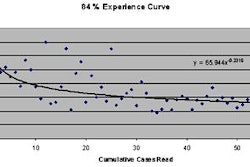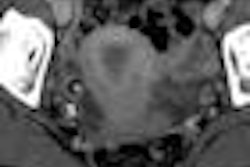A new analytic model of coronary CT angiography (CTA) found it to be moderately cheaper overall than the standard of care in patients presenting with chest pain, particularly women. The study could provide insight into which patients might benefit most from triage with coronary CTA over conventional angiography.
U.S. researchers found that costs increased slightly for men because coronary CTA was more likely to detect coronary artery disease (CAD). The results were in line with early reports demonstrating lower cost of care with initial CTA versus stress testing and cardiac enzyme tests in chest pain patients, according to study authors Joseph Ladapo, Ph.D., Dr. Udo Hoffmann, Dr. Fabian Bamberg, and colleagues from Harvard University in Cambridge, MA, and Massachusetts General Hospital in Boston (American Journal of Roentgenology, August 2008, Vol. 191:2, pp. 455-463).
Patients who present to the emergency department complaining of acute chest pain place a substantial burden on the U.S. healthcare system, Ladapo and colleagues wrote. More than 6 million such visits occurred in 2004 alone, with an estimated 30% of visits resulting in hospitalization for suspected acute coronary syndrome (ACS), a condition that includes myocardial infarction and unstable angina.
"Although some of the many patients who are admitted because of these suspicions are ultimately diagnosed with ACS, many are not, and inpatient care for negative evaluations is estimated to cost several billion dollars annually," the authors wrote.
Notably inefficient is the care of patients at low risk of ACS due to negative initial cardiac biomarkers and normal or diagnostic electrocardiogram (ECG) exams, but whose source of pain goes undiagnosed, they wrote.
To evaluate whether 64-slice coronary CTA could assess risk more cost-effectively, the researchers developed a Monte Carlo microsimulation model to compare both the costs and health effects of performing coronary CTA initially for patients with acute chest pain defined as low risk, e.g., those with negative initial troponin measurements, a normal or nondiagnostic ECG, and no history of heart disease.
Depending on the severity of atherosclerosis detected at CTA, patients would be discharged, referred for stress testing, or sent to invasive coronary angiography under the model. Significant CAD was defined as either ≥ 50% stenosis in the left main coronary artery or ≥ 70% stenosis in any other coronary artery, at which time the patients were referred for further tests and intervention. Those with milder stenoses below the thresholds were considered to have early heart disease and were followed up with biomarker measurements and stress tests as in the standard of care (SOC) pathway.
The model compared CTA to an SOC algorithm that based management on biomarkers and a variety of stress tests that might be used.
"In the SOC pathway, patients are assumed to still have normal or nondiagnostic ECGs and await the results of their final troponin measurement," Ladapo and the group wrote. "They are evaluated with a stress test if the enzyme is not found to be elevated. Patients with elevated follow-up biomarkers or whose stress tests confirm ischemia are referred for invasive coronary angiography."
The results of the two pathways were compared in terms of longevity (quality-adjusted life years [QALY]), the cost of emergency department visits, the number of hospital admissions, and the rate of missed ACS cases.
"After being discharged from the emergency department or inpatient hospital service, patients return to a baseline state of health, in which health risks are determined by age, sex, ACS history, atherosclerotic status, and cardiac health interventions," the authors wrote of their model. "They also accrue healthcare costs related to emergency department care, inpatient hospitalization, and cardiac medications and interventions." Estimates of these costs were included in the model.
Patients not diagnosed with CAD may return to the emergency department for acute chest pain episodes that fit a low-risk profile; the risk of an emergency department revisit was assumed to be 20% annually for five years after initial exam.
The prevalence of coronary atherosclerosis was derived from a large study of patients who underwent invasive angiography but were not diagnosed with ACS, the authors wrote. The distribution of ACS and non-ACS patients was derived from a study of 317 patients who presented with acute chest pain but were determined to have a low risk of ACS. Costs were based on Medicare reimbursement data and a randomized controlled trial by Goldstein et al.
The results showed that using coronary CTA to triage 55-year-old men presenting with acute chest pain increased costs slightly: Emergency department and hospital costs rose by $110, raising total healthcare costs by $200 compared to the SOC model.
Among 55-year-old women, however, the CTA strategy was cheaper, paring emergency department and hospital costs by $410 and total healthcare costs by $380.
For men and women, respectively, emergency room discharge rates were 69% and 82% for CT versus 62% and 65% in the SOC approach. Both approaches had an ACS miss rate of 1% in men; for women the ACS miss rate was 1% at SOC and 2% at CTA, the team reported.
The CTA strategy extended life expectancy by 10 days in men and six days in women compared to the SOC approach, yielding an additional 0.03 QALYs in men and 0.01 QALYs in women, respectively. The incremental cost-effectiveness ratio for CTA was $6,400 in men, and was cost-saving in women.
"Our findings suggest that CT coronary angiography-based triage for patients with low-risk chest pain yields slightly higher healthcare costs in men and lower costs in women, may be modestly more effective than SOC in prolonging life and QALYs, and is associated with low cost-effectiveness ratios in men and cost savings in women," Ladapo and his team wrote. "In men, cost-effectiveness ratios remain within the range of what is typically considered to be cost-effective, even when several parameters are varied. In women, CT coronary angiography is cost-saving under a wide variety of model assumptions."
Coronary CTA raised costs in men "primarily because it was more likely to identify patients with CAD," they explained, noting that these patients were subjected to a lifetime of costs associated with disease management, but that they gained risk reductions as a benefit thereof.
"Because coronary CT angiography is so good at ruling out disease, women ... are much more likely to avoid a costly admission," they wrote.
As was generally expected, CTA is likely to be cost-saving in populations with suspected ACS but a low prevalence of CAD, they wrote. In populations with a higher prevalence of disease, the cost effects are more difficult to predict.
Among the limitations of the study, there were significant unknown clinical factors in each of the patient populations used to construct the model. Patients were assumed not to face a higher risk of death due to their discharge, although admission might have revealed other fatal conditions. The cost of following up incidental findings was not calculated. Prospective trials currently underway are likely to reveal more effective management strategies for chest pain management, the group concluded.
"Our results suggest that [64-slice coronary CTA] may be a safe addition to the management of low-risk patients with acute chest pain and is likely to be cost-saving in women and marginally more expensive than SOC in men," they wrote. "Its high sensitivity for coronary atherosclerosis identification and treatment of CAD compared with conventional diagnostic technologies may also hasten the identification and treatment of CAD in patients with an unknown history of CAD."
By Eric Barnes
AuntMinnie.com staff writer
September 19, 2008
Related Reading
Prospective gating minimizes dose in 320-slice CTA, August 5, 2008
AHA urges cautious use of coronary CTA and MRA, July 9, 2008
Fourth-generation MDCT scanners do cardiac differently, July 8, 2008
Coronary CTA cuts costs for chest pain care, February 29, 2008
Radiation dose slashed in 64-slice coronary CTA, February 15, 2007
Copyright © 2008 AuntMinnie.com




















